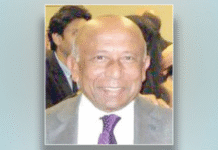
The most striking feature of Indian foreign minister S Jaishankar’s statement at the Lok Sabha on August 6 was the complete absence of the Awami League government’s egregious violation of human rights, and the killings of over 400 people (as documented so far), including youth, since July 16.
He began setting up a context for the people’s uprising saying that there had been “considerable tensions, deep divides and growing polarisation in Bangladesh politics” since the January election. “This underlying foundation aggravated a student agitation that started in June this year,” he continued. “There was growing violence, including attacks on public buildings and infrastructure, as well as traffic and rail obstructions. The violence continued through the month of July.”
While there was dissatisfaction over the 2024 election—as well as the previous two elections—the quota reform protests did not really have much to do with that. It began as merely a student movement asking for reforms in the existing quota system in public service recruitment, which turned into an anti-government movement much later due to the government’s brutal crackdown on protesters.
nment reacted with overwhelmingly excessive force against students, and police opened fireon protesters with live rounds, killing more than 400 people in the span of 23 days. The ruling party unleashed its student cadres, the Chhatra League, armed with machetes and firearms, on the unarmed protesters. It was only after then that attacks on public buildings began, which no one condoned.
Jaishankar went on to note that “Despite a Supreme Court judgement on 21 July, there was no let-up in the public agitation.” He added, “Various decisions and actions taken thereafter only exacerbated the situation. The agitation at this stage coalesced around a one-point agenda, that is that Prime Minister Sheikh Hasina should step down.”
Since the Indian foreign minister glosses over the former government’s brutality, it appears to paint the democratic movement behind Sheikh Hasina’s fall with a nefarious intention from its genesis—which fits into the Awami League’s narrative—that this was a movement fomented by the BNP, Jamaat or even external forces such as the US. This is far removed from the reality of the Bangladeshi public sentiment. Sheikh Hasina’s government murdered so many people before meeting the quota demands. There was a nationwide internet blackout for five days. The student movement had nine demands before the hearing and verdict, including an apology from the ousted prime minister and resignation of former ministers, including Obaidul Quader and Asaduzzaman Khan Kamal, for abusing law enforcement.
On the surface, the government said it was open to negotiations with students, yet there were block raids during the nights where law enforcers came hunting for students. More than 11,000 people were arrested in just two weeks. Innocent children were put in jails and framed for murders committed by the police—even ones that were recorded, like Abu Sayed’s. The “step down” demand came to the fore on August 3. It was certainly not soon after the court verdict, when the situation was still reversible had Hasina wished to apologise and reconcile. But that was simply out of the question for an increasingly egotistical autocrat.
Jaishankar then jumps to August 4, when he says, “Events took a very serious turn.” It did indeed. Awami League had by then decided to unleash its full force onto the protesters, who took to the streets despite the curfew, only to face the police baby-sitting armed goons of the Awami League. Violence shook the nation; the death toll kept climbing to nearly 100 people—the highest and deadliest ever for a single-day protest in the nation’s history. Public anger only mounted; student protesters called for a “March to Dhaka” on August 5. In response, hundreds of thousands took to the streets in Dhaka and other surrounding towns ready to converge on Shahbag.
That was when the law enforcers realised the situation was beyond salvation and counselled Sheikh Hasina to leave. Initially, she reportedly refused and urged for using even more force to subdue the crowd. The army refused. Hasina was finally convinced to leave. It was a revolution spearheaded by students that succeeded in toppling a dictatorial regime of 15 years.
The fact that the BNP and Jamaat-e-Islami took advantage of what turned into an anti-government campaign and publicly supported it was public knowledge. But entire communities—civilians from all walks of life—came out in support of the campaigners; the nation stood united against the ruling party. Hospitals gave free medical support, and general people donated to their common funds for food and water. Everyone sympathised with the protesters who were braving bullets on the streets and torture in the jail cells. Six coordinators were detained by the police and confined at the detective bureau against their will for several days without any regard for law or their rights.
What followed after she left her official residence was an outpouring of pent-up hatred for anything and everything linked to Hasina and the Awami League. Desecration of Sheikh Mujib’s statues and murals and even his residence in Dhanmondi was heart-wrenching and hurt millions of Bangladeshis.
With the police gone and no law and order in place, minorities became an unfortunate target. The Daily Star reported violence against Hindu homes and businesses in 27 districts on August 5. These crimes must be investigated as the police are getting back on duty.
Hasina’s Awami League consciously colluded with the religious fundamentalists, placating them and pandering to them to keep them at bay, only to make sure that Hasina remained at the helm without too much trouble from the right. It was the Awami League government that changed school textbooks, took out pieces by Hindu authors to replace them with stories and poems by unknown Muslim authors. Pictures and drawings were changed exactly as demanded.Besides restoring democracy, reviving the truly secular mindset of the masses is another uphill task that Bangladesh will have to undertake, now that Awami League is gone.
But, back to Jaishankar’s statement: the blatant disregard for brewing tension among Bangladeshis, Awami League’s intolerance for dissent and telltale signs of the Hasina regime turning into a classic autocrat shows a rather myopic and oversimplified Indian take of what is happening in Bangladesh. Jaishankar’s articulate and witty tete-a-tetes with journalists or at discussion panels around the world convincingly demonstrates that he does not lack the calibre to appreciate these nuances. One wonders, then, if he had not been properly briefed by his aides on what actually happened in Bangladesh.
Just as this is an opportunity for Bangladesh to rebuild its future free from Awami League’s clutches, it is also an opportunity for India to do some introspection. Bangladesh has just witnessed a people’s uprising toppling a dictator—which will be a classic textbook case of the fall of an autocratic regime like Ceausescu or Marcos. And yet India remains extremely apprehensive about what is to come. India built relations with Awami League instead of Bangladesh. The Indian establishment has been more than happy to support Awami League for expedience despite its faults, and in the process alienated the people of the country. Today, with the ouster of Hasina and the Awami League, India is quite naturally seeing more than its fair share of criticism and dip in popularity.
It is really high time that Jaishankar asked his aides, or whoever is in charge of setting the Bangladesh agenda, how India backed itself to such a corner that it cannot join in the jubilation of a nation or empathise with our celebrations. He should ask how it is that India fails to see the new regime as a result of the mass people’s uprising that it was, and why it needs to distort it by labelling it as the machinations of Pakistan, China or the US. Why is it that when we are relieved to have rid ourselves of a dictator, India is apprehensive that the djinn is out of the bottle?
Daily Star









